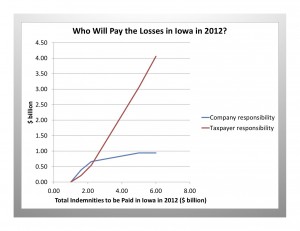
Several members of Congress are using the drought to push for a costly and duplicative disaster assistance program and passage of the worst farm bill in decades.
But taxpayers have already given farmers a gold-plated disaster program – it’s called crop insurance – and it will pay farmers indemnities regardless of whether Congress passes a farm bill.
Thanks to generous taxpayer subsidies, most farmers in the Corn Belt have insurance. That’s largely because taxpayers provide, on average, 62 percent of the insurance premiums for farmers and send $1.3 billion a year to crop insurance companies to sell and service farmers’ insurance policies. And taxpayers, not insurance companies, pick up most of the cost when insurance policies pay out – especially in a year as bad as this one.
In states like Iowa, Illinois, and Indiana – where the drought’s impact on farmers is the worst – more than 80 percent of crop farmers have obtained taxpayer-subsidized insurance.
Yesterday, Iowa State University agricultural economist Bruce Babcock and Craig Cox of the Environmental Working Group explained why crop insurance will provide farmers support during the drought:
In fact, Babcock noted that many farmers stand to make more money even if the drought cuts into their yields because of the peculiar way crop insurance works: some farmers have purchased a revenue protection policy that allows them to collect a payment tied to the “harvest price” of their crop in October rather than the average price in February. As yields fall during the drought and crop prices inexorably rise, so too does the “harvest price” farmers can “earn” from failed crops.
It’s the taxpayers who should be worried, not crop insurance companies, because the taxpayers absorb a larger and larger share of the indemnities paid to farmers as crop losses mount, according to Babcock. The losses crop insurance companies might experience are capped, but there is no cap on the losses taxpayers will pick up.
That’s right. Taxpayers pay three times. We pay most of the insurance premiums. We pay insurance companies to sell the policies. And we pay much of the indemnities, especially during a year with very bad weather and big losses.
Who wins? Clearly, crop farmers have a gold-plated safety net that is more akin to a security blanket because so much of the risk of farming has been handed to taxpayers.
But the biggest winners are crop insurance companies.
Rather than cutting nutrition assistance and lavishing new subsidies on insurance companies and crop farmers, as the House Agriculture Committee has proposed, Congress should do what it seems to do best: nothing. This should be easy for a do-nothing Congress. Crop insurance programs do not expire and do not have to be reauthorized in the farm bill. Same deal with feeding assistance programs.
But if Congress does act, it should reform, not expand, a crop insurance program that sends windfall profits to crop insurance companies, lavish subsidies to farmers for arcane insurance policies that earn them more money from the treasury than from their fields and that passes most of the liability onto taxpayers
In particular, Congress should not renew costly supplemental revenue assistance payments as some senators have proposed. And Congress should not, as Cox noted jam through a deeply flawed farm bill that expands rather than reforms crop insurance.
Who are the real losers in the drought? Poor consumers. That’s because the cost of feeding farm animals will rise, pushing up prices of basic staples like milk and other dairy products. Low-income Americans spend more than 20 percent of their after-tax income on food.
According to Babcock (click here for his full analysis), common sense crop-insurance reforms that reduce insurance subsidies could save the taxpayers more than $40 billion over the next 10 years while continuing to provide farmers help when they need it.




